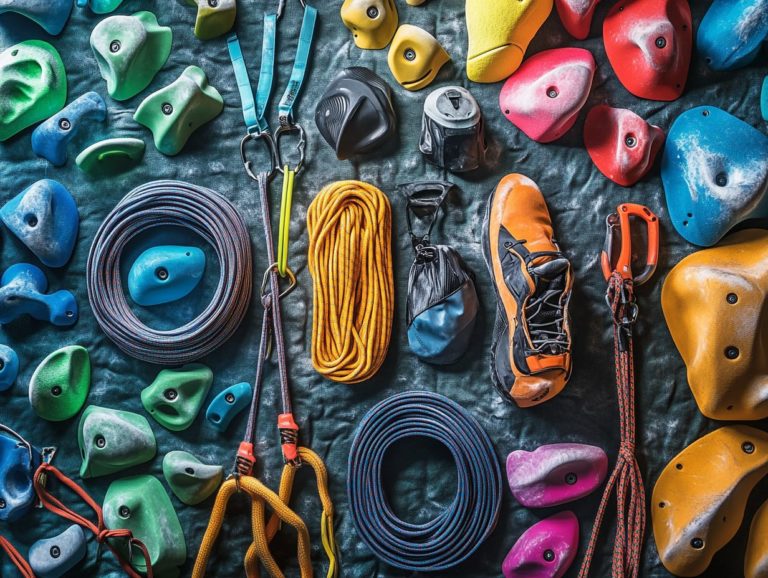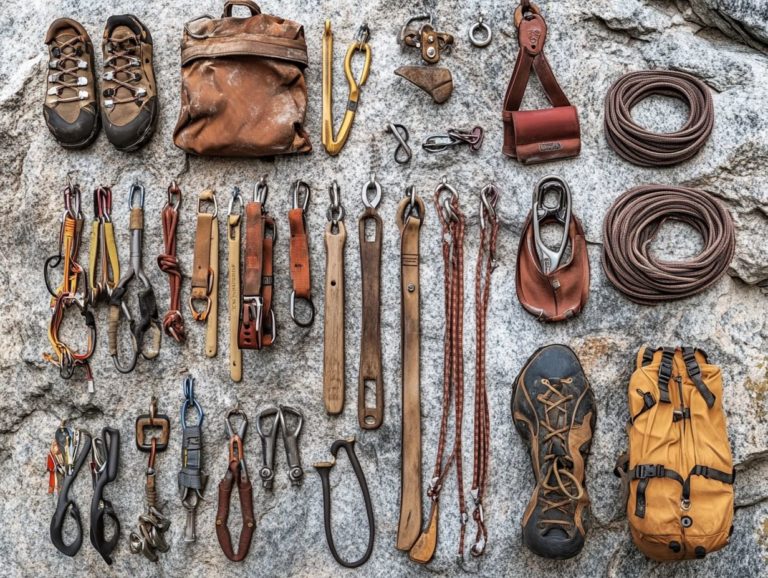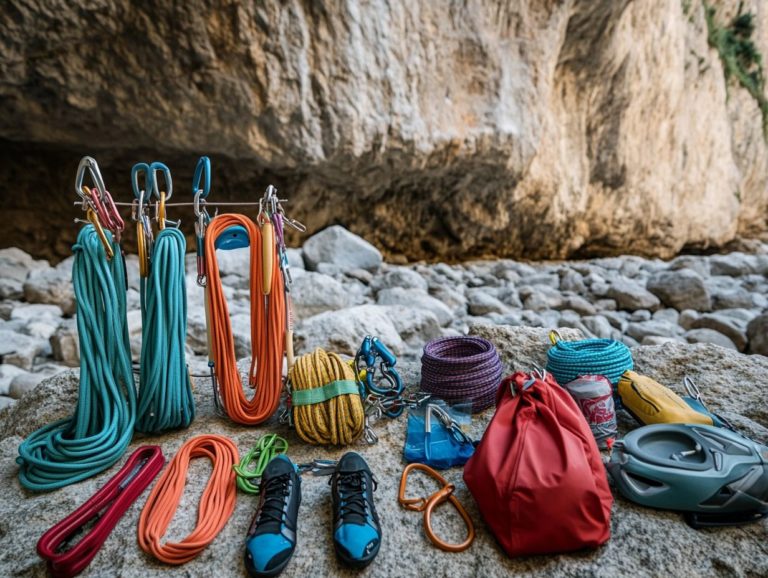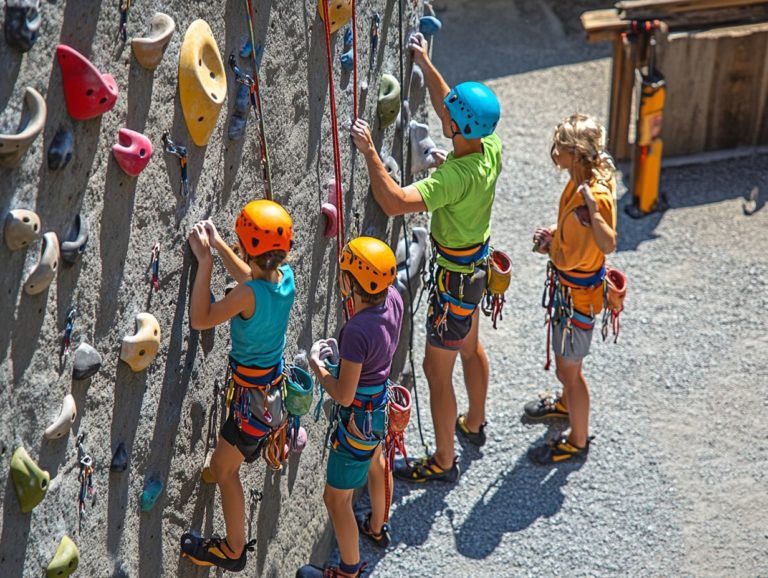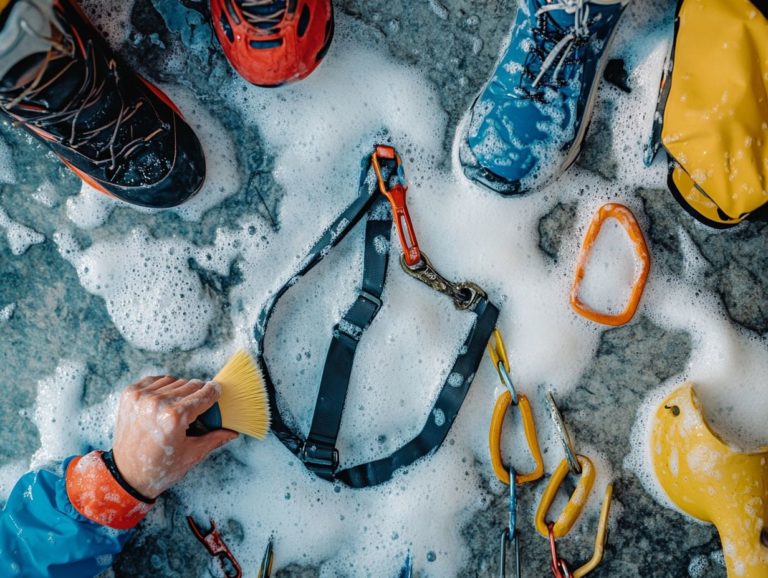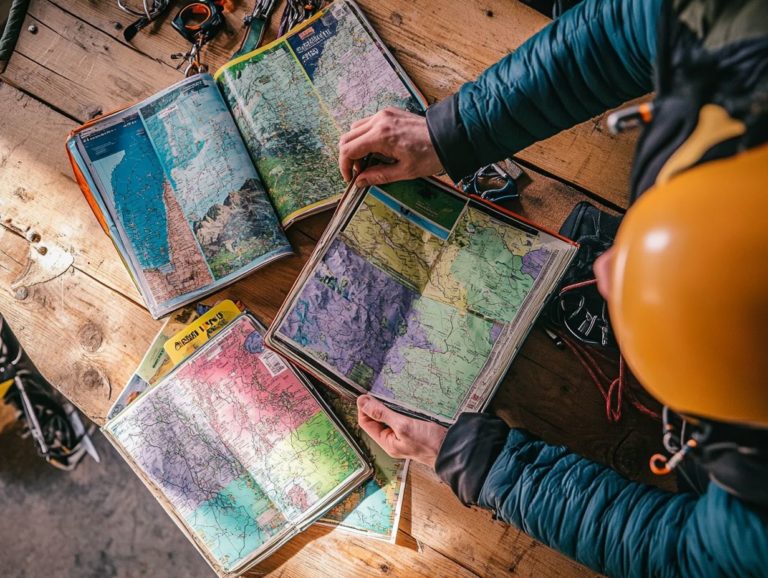The Best Climbing Gear for Multi-Pitch Routes
Planning your next climbing adventure that involves multiple sections? The gear you choose can transform your journey from exhilarating to daunting.
Discover the essentials of climbing gear, from climbing shoes to helmets, and everything in between. You’ll find valuable insights on selecting the perfect size and fit, along with recommendations for top brands and essential guidelines for maintaining your equipment.
Get ready to gear up! Uncover effective packing and organization strategies to elevate your climbing experience. Prepare yourself to conquer your next ascent with confidence!
Contents
- Key Takeaways:
- Essential Gear for Your Next Climbing Adventure: Climbing Shoes
- Harness
- Belay Device
- 4. Helmet
- 5. Chalk Bag
- 6. Quickdraws
- 7. Rope
- 8. Carabiners
- 9. Anchor Building Materials
- 10. Climbing Protection
- 11. Climbing Backpack
- 12. Climbing Clothes
- 13. Gloves
- 14. Headlamp
- 15. First Aid Kit
- What Are the Essential Items for Multi-Pitch Climbing?
- Frequently Asked Questions
- What is multi-pitch climbing and why do I need specific gear for it?
- What are the essential pieces of gear for multi-pitch routes?
- What type of rope is best for multi-pitch climbing?
- Why is a good harness important for multi-pitch routes?
- What makes a good belay device for multi-pitch routes?
- Do I need special shoes for multi-pitch climbing?
Key Takeaways:
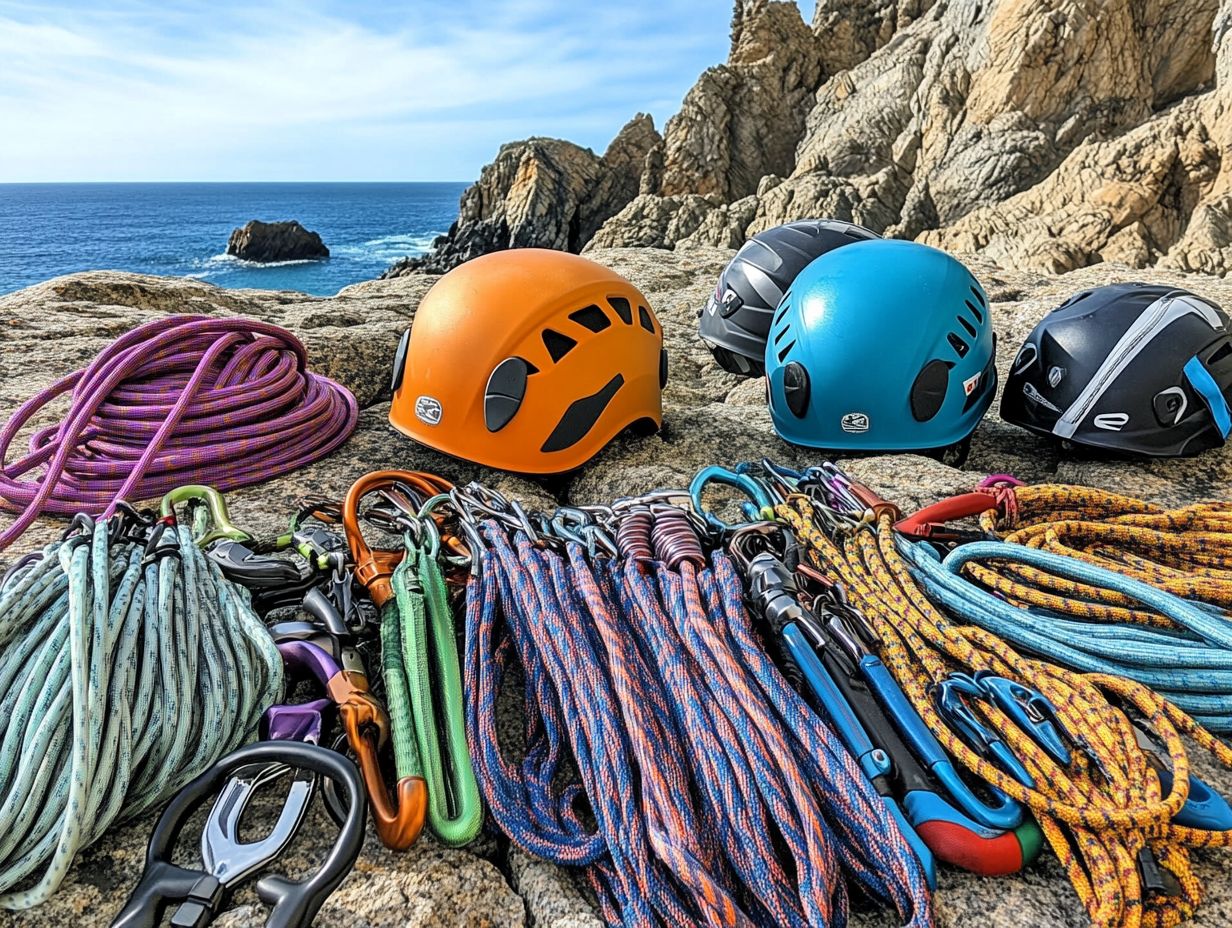
- Properly fitting and comfortable climbing shoes are crucial for successful climbing routes that involve multiple sections.
- Investing in high-quality and durable climbing gear from trusted brands ensures safety and reliability on the climb.
- Regularly inspect and replace worn-out gear to maintain safety and efficiency while climbing.
Essential Gear for Your Next Climbing Adventure: Climbing Shoes
Climbing shoes are absolutely essential for you as a climber. They provide the grip, support, and protection necessary to tackle various climbing routes whether you’re scaling Boulder Canyon in Colorado or taking on climbing routes that involve multiple sections across the USA. The right pair can significantly elevate your climbing experience by offering stability and precision during critical foot placements, which is vital whether you’re sport climbing or venturing into trad climbing.
When selecting climbing shoes, you’ll find a variety of options, including aggressive, moderate, and neutral designs. Aggressive shoes excel in precision, making them perfect for technical routes. Moderate shoes strike a balance between comfort and performance, giving you the versatility needed for all-day climbs. Neutral shoes prioritize comfort, often becoming the go-to choice for beginners or those seeking longer wear.
As you evaluate your options, consider key features such as the type of rubber, fit, and closure system, which significantly impact your safety and performance. Brands like Black Diamond and Mammut offer a range of tailored choices catering to specific climbing styles. Remember, ensuring the proper fit is crucial; your shoes should feel snug without causing excessive pain, allowing for effective footwork and weight distribution while minimizing the risk of injury.
Harness
A climbing harness is an essential piece of climbing gear that guarantees your safety and security as you navigate various terrains. It allows you to attach yourself effectively to ropes, anchors, and belay devices.
Different harness types are designed to cater to the needs of various climbing styles. For instance, sport climbing often calls for a lightweight and minimalistic design that enhances mobility, while multi-pitch climbing typically requires a more robust build that offers additional comfort during long ascents. If you’re interested in exploring options specifically for solo climbing, check out the best gear for solo climbers.
Safety features are paramount. Look for reinforced tie-in points and quick-adjust leg loops to ensure a snug fit. Proper attachment techniques like using the figure-eight knot, a popular knot used in climbing for safety are crucial for maximizing your safety.
Regular maintenance is key; inspect for wear and tear, and ensure that buckles are functioning correctly to significantly extend the lifespan of this essential gear.
Belay Device
Belay devices are essential for your safe climbing practices, providing controlled descent and fall protection, making them a fundamental part of your gear setup.
With a wide range of options available today, you can select a device that perfectly suits your specific needs. For example, the ATC Guide is a versatile choice for both top-rope and rappel situations. If you’re looking for added security during lead climbing, the Petzl GriGri stands out with its assisted braking feature. Additionally, Black Diamond’s offerings are renowned for their durability and functionality, making them essential in your top 10 must-have climbing gear accessories for tackling the challenges of outdoor climbing.
No matter which device you choose, effective communication with your climbing partners is crucial. This ensures that the belay is executed safely and efficiently, helping prevent potential accidents and enhancing your overall climbing experience.
So gear up and hit the rocks with confidence!
4. Helmet
A climbing helmet is an important piece of outdoor gear. It provides protection against falling debris and impacts during your climbing adventures. This significantly enhances your safety on multi-pitch climbs, which involve ascending more than one rope section.
A helmet can turn a scare into a minor issue. It protects you from serious injuries, especially in vertical environments where rockfall is a real threat. You have a variety of helmet options, from hard-shell versions that offer maximum protection to lightweight foam helmets designed for comfort during long ascents.
Reputable brands like Petzl, Black Diamond, and Mammut offer helmets that have been rigorously tested. This ensures you receive quality safety. Choose a helmet that fits snugly without being overly tight. A proper fit dramatically influences its effectiveness.
Don t forget that regular maintenance such as checking for cracks or damage is key to upholding your gear s integrity and reliability.
5. Chalk Bag
A chalk bag is a small but essential accessory in your climbing gear. It provides the crucial chalk needed to maintain grip on holds. This enhances both your performance and confidence as you tackle challenging routes.
Choosing the right type of chalk makes a noticeable difference in your ascent. It effectively absorbs moisture and minimizes slippage on various surfaces, ensuring you stay grounded when the going gets tough.
Chalk bags come in various shapes and sizes, featuring options like drawstrings or cinch closures for easy access while you scale heights. To optimize your hands-free chalk access, position your bag correctly on your harness. Regularly check and clean it to prevent chalk buildup, keeping your load light and ensuring effective use.
Keep your chalk bag in top shape to focus on climbing, not fixing. Proper care ensures its longevity and allows you to concentrate on refining your techniques and elevating your overall performance.
6. Quickdraws
Quickdraws are essential for secure and effortless connections between your climbing rope and anchors. They ensure you navigate routes with both safety and efficiency.
Typically, a quickdraw consists of two carabiners linked by a robust, sewn sling. This setup is vital for minimizing rope drag and optimizing your safety during ascents. You can choose from various types, such as wiregate and keylock designs, each offering distinct advantages in weight and usability.
Understand how these quickdraws operate in different climbing systems, like sport, trad, or multi-pitch. To enhance your experience, consider checking out the best climbing gear for outdoor adventures. Prioritize safety, including proper clipping techniques and regular inspections for wear and tear, to prevent potential accidents as you tackle various climbing scenarios.
7. Rope
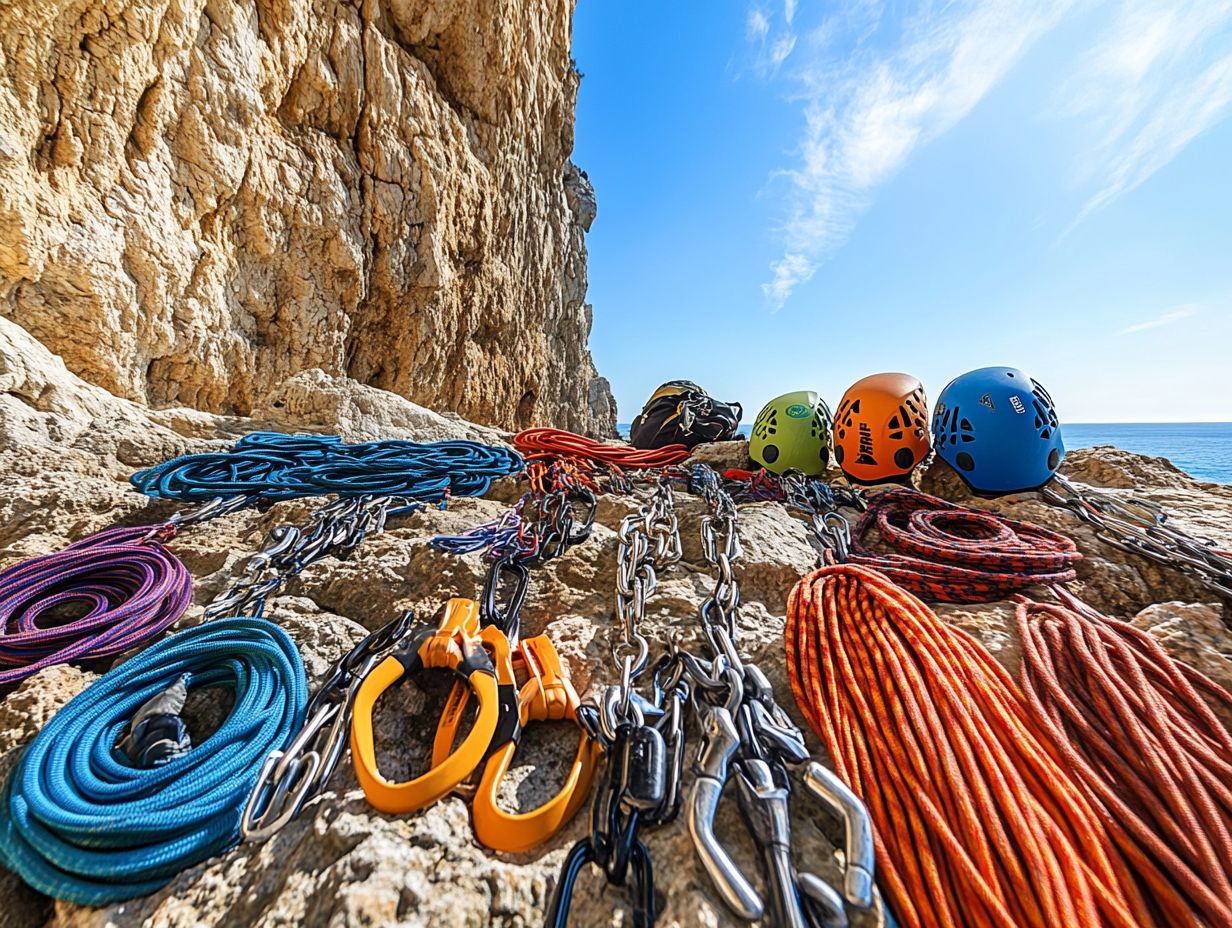
Climbing ropes are essential for your safety and success in any climbing venture. They provide the crucial support you need for rappelling, belaying, and protecting against falls.
These ropes come in various types, each engineered for specific climbing styles. Whether you re into sport, trad, or alpine climbing, dynamic ropes with their inherent elasticity are your best bet for lead climbing, as they absorb fall energy effectively. On the other hand, static ropes excel in activities like canyoning or hauling gear, thanks to their minimal stretch.
As a climbing enthusiast, pay attention to fall factors to ensure your rope’s strength can withstand potential impacts during a descent. Regularly inspect and maintain your ropes by cleaning and storing them properly to significantly extend their lifespan.
When choosing the right rope, consider factors like length, diameter, and intended use. Making informed choices can greatly enhance both your safety and performance on the rock.
8. Carabiners
Carabiners are essential elements of your climbing gear. They act as vital connectors for ropes, harnesses, and anchors.
They play a significant role in enhancing both safety and efficiency in your climbing systems.
Among the many types available, locking carabiners stand out as a must-have for securing your gear in high-risk situations. They effectively prevent any accidental openings.
These carabiners come in various styles, such as screw-lock and auto-lock. Each is specifically engineered to tackle unique climbing challenges.
When choosing the right carabiner for your adventures, consider your intended use whether it’s sport climbing, traditional climbing, or mountaineering as well as the strength rating and ease of operation. Always lock your carabiner before trusting it. Your safety depends on it!
Regularly inspect it for any signs of wear and tear. With the right climbing gear, you can enhance both safety and performance.
Such diligence not only boosts your performance but also cultivates a significantly safer climbing experience.
9. Anchor Building Materials
Anchor building materials are essential for establishing secure points of protection. They allow you to navigate challenging terrain safely and effectively during your climbs.
The choice of anchors whether static or dynamic significantly influences your safety and the success of your route.
Materials such as webbing, slings, and carabiners come with varying degrees of strength, durability, and performance under load. Making the right selection is crucial for your climbing endeavors.
By understanding the different types of anchors like natural versus artificial, and single-point versus multi-point you can strategize more effectively.
Employing proper anchor building techniques, including load distribution and redundancy, is vital for minimizing risks. This comprehensive approach not only affects your safety but also enhances your overall climbing experience.
It instills confidence in your equipment choices and climbing methods as you tackle even the most daunting ascents.
10. Climbing Protection
Climbing protection encompasses the array of devices and techniques designed to safeguard you against falls. It is an essential element of climbing techniques and safety practices.
To enhance your safety while navigating challenging terrains, it’s vital to understand the various types of climbing protection available, including both passive and active options.
Effective climbing techniques will help you utilize passive protection more efficiently. This typically includes gear like nuts and hexes that can be securely wedged into rock cracks, creating reliable anchor points.
In contrast, active protection features devices such as camming units that expand upon placement. These provide dynamic holding power that adapts to your movements.
The effective use of these tools hinges on the specific rock environment, your awareness of the associated risks, and understanding the fall factor the ratio of the distance fallen to the length of rope that catches the fall.
Mastering proper placement techniques is crucial to ensuring your utmost safety during climbs.
11. Climbing Backpack
A climbing backpack is essential for transporting your climbing gear. It offers ample space and organization for everything from ropes to approach shoes, ensuring a seamless climbing experience.
This backpack is crafted to optimize weight distribution. It allows you to maintain balance and agility on challenging terrains, especially when carrying your climbing essentials.
Thoughtfully arranged compartments mean that each gear item has its designated spot. This makes it easy to access what you need without sifting through a chaotic jumble.
Many models come equipped with hydration options, like integrated reservoirs or external pockets for water bottles. This ensures you stay refreshed during your ascent.
Effectively organizing your climbing gear not only boosts efficiency but also enhances safety. It allows you to concentrate fully on your climb without the distraction of gear accessibility.
12. Climbing Clothes
Climbing clothes are crafted to offer you comfort, flexibility, and durability. They significantly elevate your overall climbing experience across various terrains and conditions.
Selecting the right attire is essential. It ensures best performance while prioritizing your climbing safety during climbs. Different weather scenarios require specific clothing choices, such as lightweight, breathable fabrics for warm, sunny days or insulated layers to keep you cozy against the chill of high-altitude adventures.
Your chosen climbing style will also influence your fabric selections. For example, stretchy materials are ideal for bouldering, allowing for unrestricted movement. In contrast, durable, abrasion-resistant options are better suited for rugged ascents. Mastering layering enhances your adaptability, making it easier to regulate body temperature and maintain comfort as you transition between varying elevations and weather patterns.
13. Gloves
Climbing gloves are essential for protecting your hands, enhancing your grip, and minimizing the risk of injuries as you tackle rugged terrain with various climbing techniques.
These gloves come in a variety of materials, including leather, synthetic fabrics, and a combination of both. Each is crafted to strike the perfect balance between durability and dexterity. You might prefer leather gloves for their toughness during demanding ascents, while lightweight synthetic options are perfect for warmer days when breathability is key.
Look for specialized gloves that feature reinforced fingertips or padded palms. These enhancements help absorb shock and improve your handling of ropes and equipment. By selecting the right gloves for your specific climbing conditions, you boost your grip and significantly reduce the chances of blisters, abrasions, and cold exposure.
This thoughtful choice ultimately elevates both your safety and performance on challenging routes.
14. Headlamp
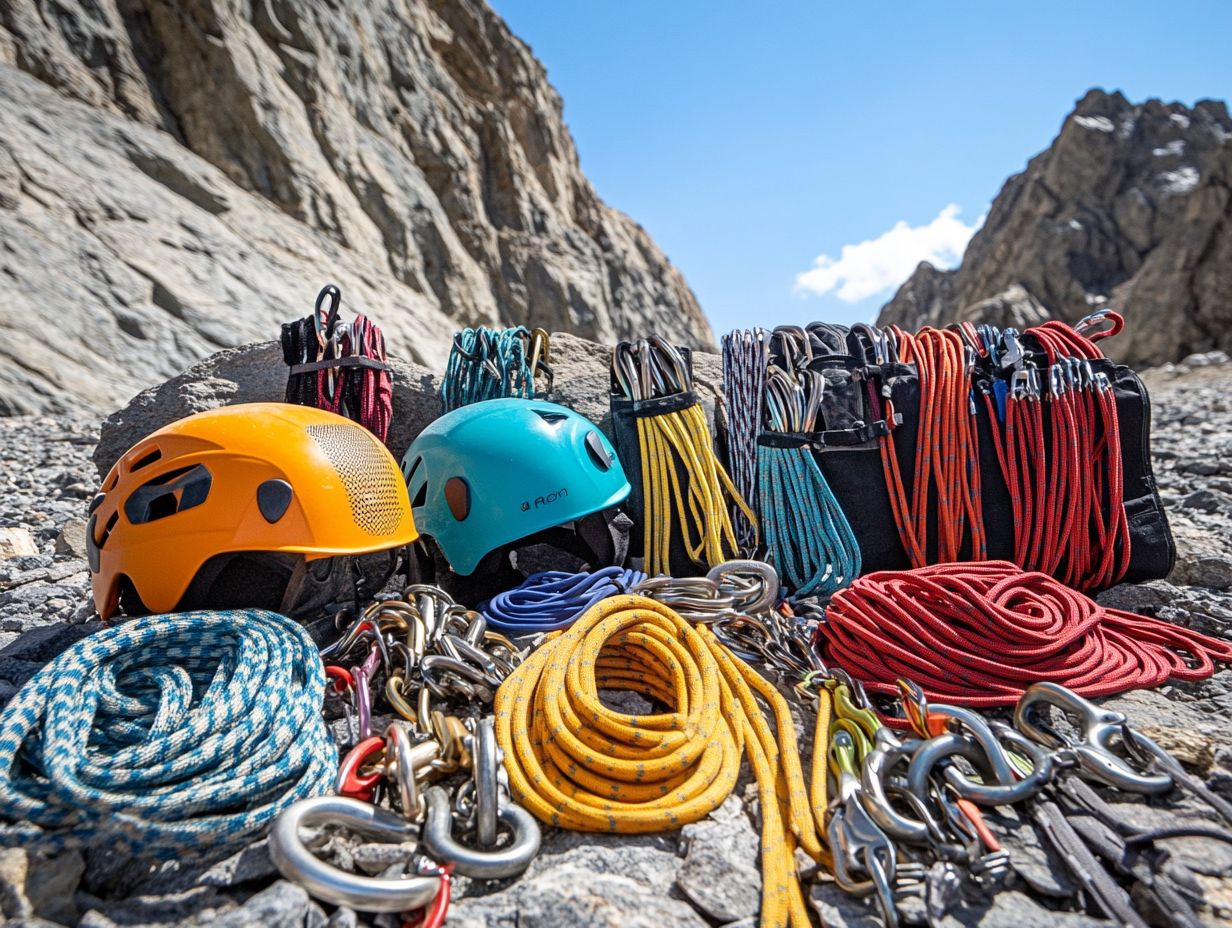
A headlamp is an essential piece of climbing gear that guarantees visibility during early morning or late evening ascents. This greatly enhances both safety and readiness as you navigate the terrain with your climbing partners.
When selecting a headlamp, consider critical features like brightness, measured in lumens. This directly influences how clearly you can see the path ahead in low-light conditions. Battery life is equally essential; you need dependable power that lasts through extended climbs, especially during multi-pitch routes where accessing extra batteries might not be an option.
Don t overlook the weight of the headlamp; unnecessary bulk can lead to fatigue over long durations. Choosing a lightweight, powerful, and durable model can significantly enhance your climbing experience and overall safety during exhilarating adventures.
15. First Aid Kit
A first aid kit is a must-have for any climbing adventure! It equips you with vital supplies needed to address injuries and emergencies during your outdoor climbing experiences. Don’t hit the trails without it!
As a climber, being well-prepared means recognizing common risks you might encounter, like falls, scrapes, or exposure to harsh weather. Your kit should include essential items:
- Adhesive bandages
- Antiseptic wipes
- Compression wraps
- Pain relief medications
These items will help you effectively manage minor injuries on the go. It s also wise to include a splint for stabilizing potential fractures and a mylar blanket to keep warm in case of sudden temperature drops, ensuring your climbing safety.
Familiarizing yourself with these supplies promotes effective injury management and enhances your overall climbing experience. It instills confidence and awareness in the face of unexpected challenges and potential risks.
What Are the Essential Items for Multi-Pitch Climbing?
Multi-pitch climbing demands your careful attention to a range of essential items, from climbing gear to safety equipment. You need a robust rope designed for multi-pitch routes, delivering the strength and durability needed for safe ascents.
Alongside this, having a reliable anchor kit is non-negotiable. These kits typically include cams and nuts pieces of gear used to secure climbers to the rock, and it’s important to choose the most reliable climbing gear brands that secure you at various points along the climb, keeping you safe.
Don’t overlook quickdraws; these are devices that connect the climbing rope to anchors, allowing for seamless transitions as you navigate the vertical landscape. For those interested in climbing in urban environments, check out the best climbing gear for urban climbing. Clear communication is also vital during the climb; tools like radios or whistles can significantly enhance safety.
Ultimately, thorough research and meticulous preparation will equip you with both confidence and strategy, minimizing risks and maximizing enjoyment as you tackle those challenging rock faces with proper climbing techniques.
How Can One Determine the Right Size and Fit for Climbing Gear?
Determining the right size and fit for your climbing gear is essential for both safety and performance. A proper fit allows you to move freely and confidently on various climbing routes.
A proper fit can elevate your entire climbing experience. Any discomfort may distract you, impacting your focus and technique. When selecting key equipment like harnesses, climbing shoes, and helmets, consider aspects such as adjustability, foot shape, and head circumference to ensure overall climbing safety.
To achieve optimum comfort, take the time to measure yourself accurately and try on multiple options before making your decision. For harnesses, ensure a snug fit around your waist that doesn’t feel constricting. When trying on climbing shoes, pay attention to the balance between tightness and discomfort.
Ensuring that helmets fit securely and comfortably on your head, with minimal movement, can greatly enhance your safety during climbs.
What Are Some Recommended Brands for Climbing Gear?
Selecting the right brands for your climbing gear can profoundly influence both your safety and performance. Several reputable companies provide high-quality equipment specifically designed for climbers.
Among the elite names in the industry, Black Diamond, Petzl, and Mammut stand out. Each brand is renowned for its steadfast commitment to innovation and safety features. Black Diamond excels with unmatched craftsmanship and dynamic designs.
Petzl is lauded for its groundbreaking advancements in rescue and climbing technologies, including innovative belay devices that prioritize user safety. On the other hand, Mammut emphasizes durable materials and rigorous testing, ensuring their climbing gear keeps you safe in tough situations.
In the world of outdoor adventure, quality truly is paramount.
How Often Should Climbing Gear Be Replaced?
Don’t forget to check your gear regularly! Regularly replacing your climbing gear is essential for maintaining both safety and performance. Wear and tear can significantly compromise the integrity of your vital equipment.
To ensure optimal safety, routinely inspect your climbing ropes, harnesses, and helmets for any signs of damage or excessive wear. For example:
- Check your rope for frays or nicks.
- Examine climbing harness buckles and stitching for integrity.
- Assess your helmet for cracks or dents.
Keeping your gear clean and dry and storing it away from direct sunlight or sharp objects will help prolong its lifespan.
It’s also wise to familiarize yourself with the manufacturer s guidelines regarding replacement timelines. When in doubt about your gear’s condition, it’s always better to err on the side of caution; replacing it is the safest choice you can make.
What Are Some Tips for Packing and Organizing Climbing Gear?
Effectively packing and organizing your climbing gear is crucial for ensuring quick access and efficiency during your climbs, while also minimizing the risks associated with misplaced equipment.
To achieve this, begin by categorizing your gear into essential groups such as harnesses, ropes, carabiners, and safety equipment. Prioritizing items based on the specific demands of your climb will further streamline the packing process. For instance, considering the top climbing gear for rock climbers can enhance your experience. Items you’ll use frequently should be placed in easily accessible compartments of your climbing pack. Less critical gear can be stored deeper within.
This level of organization enhances your safety and fosters a smoother workflow, allowing you to focus on the adventure ahead instead of frantically searching for gear mid-ascent.
Frequently Asked Questions
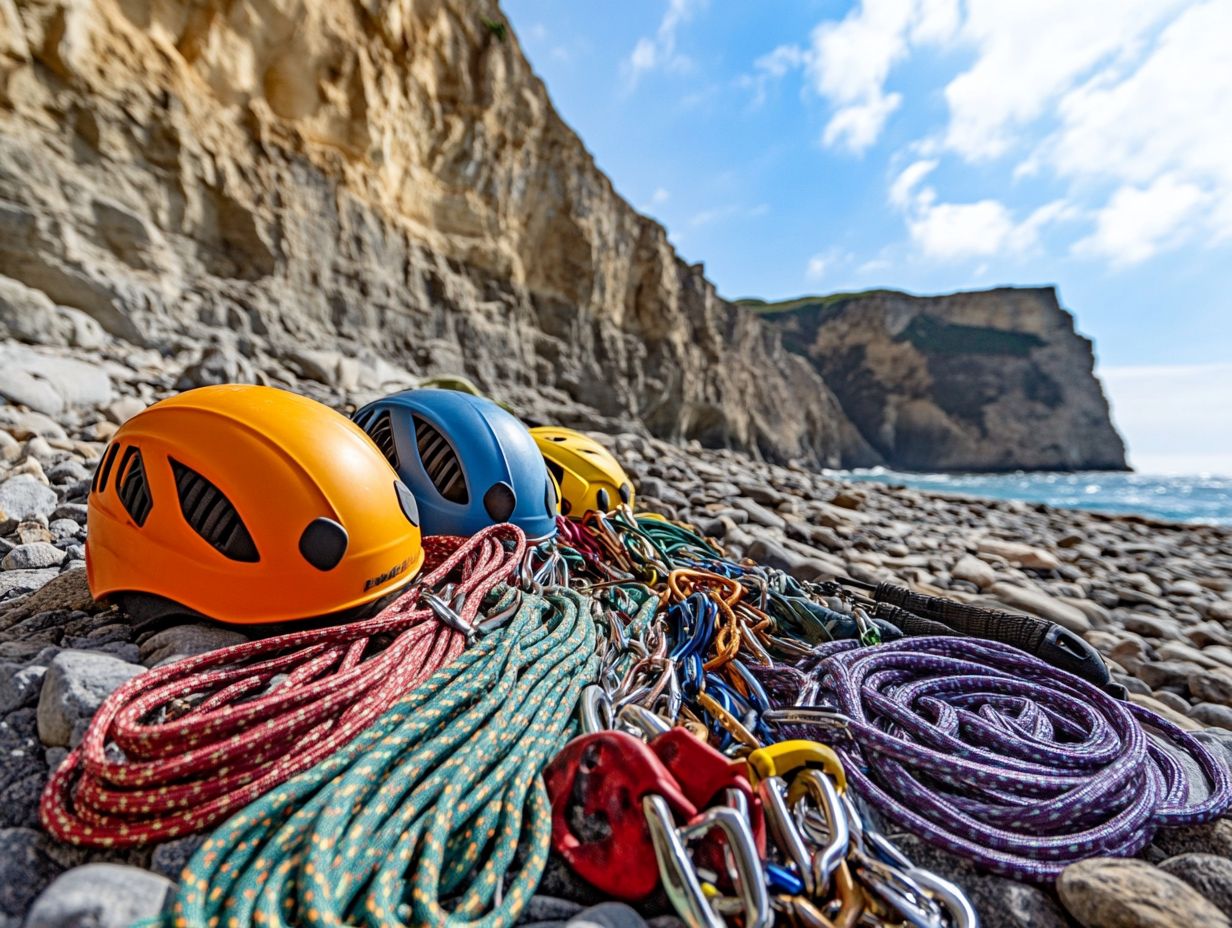
What is multi-pitch climbing and why do I need specific gear for it?
Multi-pitch climbing involves ascending a route that is longer than a single rope length, requiring multiple stops and belays. Specific gear is necessary for the safety and efficiency of this type of climbing.
What are the essential pieces of gear for multi-pitch routes?
The best climbing gear for multi-pitch routes includes a rope, harness, helmet, climbing shoes, a belay device, quickdraws, slings, and a personal anchor system. Always choose high-quality gear to ensure your safety and boost your confidence!
What type of rope is best for multi-pitch climbing?
A dynamic rope with a minimum length of 60 meters is recommended for multi-pitch climbing. The rope should also be rated for the weight of both climbers and have a durable sheath to withstand multiple pitches.
Why is a good harness important for multi-pitch routes?
A comfortable and well-fitting harness is essential for multi-pitch climbing, as you will be spending extended periods of time suspended in it. Look for a harness with adjustable leg loops and plenty of gear loops for easy access to your equipment.
What makes a good belay device for multi-pitch routes?
A belay device with assisted braking is recommended for multi-pitch climbing as it helps control the rope during climbing and reduces the risk of dropping your climbing partner. Auto-locking devices, such as the Petzl GriGri, are popular choices for multi-pitch routes.
Do I need special shoes for multi-pitch climbing?
While any climbing shoe can be used for multi-pitch routes, it is important to choose a comfortable pair that you can wear for extended periods of time. Look for shoes with a moderate downturn and a neutral toe box for all-day comfort.
Ready to gear up for your next climb? Let’s dive into the essentials together!

